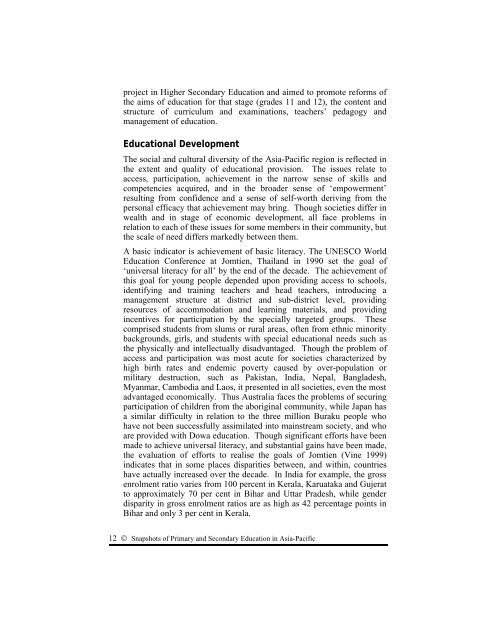Download PDF, 752KB - UNESCO Bangkok
Download PDF, 752KB - UNESCO Bangkok
Download PDF, 752KB - UNESCO Bangkok
Create successful ePaper yourself
Turn your PDF publications into a flip-book with our unique Google optimized e-Paper software.
project in Higher Secondary Education and aimed to promote reforms ofthe aims of education for that stage (grades 11 and 12), the content andstructure of curriculum and examinations, teachers’ pedagogy andmanagement of education.Educational DevelopmentThe social and cultural diversity of the Asia-Pacific region is reflected inthe extent and quality of educational provision. The issues relate toaccess, participation, achievement in the narrow sense of skills andcompetencies acquired, and in the broader sense of ‘empowerment’resulting from confidence and a sense of self-worth deriving from thepersonal efficacy that achievement may bring. Though societies differ inwealth and in stage of economic development, all face problems inrelation to each of these issues for some members in their community, butthe scale of need differs markedly between them.A basic indicator is achievement of basic literacy. The <strong>UNESCO</strong> WorldEducation Conference at Jomtien, Thailand in 1990 set the goal of‘universal literacy for all’ by the end of the decade. The achievement ofthis goal for young people depended upon providing access to schools,identifying and training teachers and head teachers, introducing amanagement structure at district and sub-district level, providingresources of accommodation and learning materials, and providingincentives for participation by the specially targeted groups. Thesecomprised students from slums or rural areas, often from ethnic minoritybackgrounds, girls, and students with special educational needs such asthe physically and intellectually disadvantaged. Though the problem ofaccess and participation was most acute for societies characterized byhigh birth rates and endemic poverty caused by over-population ormilitary destruction, such as Pakistan, India, Nepal, Bangladesh,Myanmar, Cambodia and Laos, it presented in all societies, even the mostadvantaged economically. Thus Australia faces the problems of securingparticipation of children from the aboriginal community, while Japan hasa similar difficulty in relation to the three million Buraku people whohave not been successfully assimilated into mainstream society, and whoare provided with Dowa education. Though significant efforts have beenmade to achieve universal literacy, and substantial gains have been made,the evaluation of efforts to realise the goals of Jomtien (Vine 1999)indicates that in some places disparities between, and within, countrieshave actually increased over the decade. In India for example, the grossenrolment ratio varies from 100 percent in Kerala, Karuataka and Gujeratto approximately 70 per cent in Bihar and Uttar Pradesh, while genderdisparity in gross enrolment ratios are as high as 42 percentage points inBihar and only 3 per cent in Kerala.12 © Snapshots of Primary and Secondary Education in Asia-Pacific
















